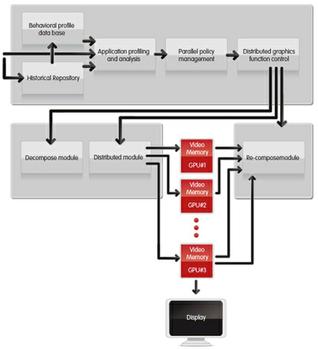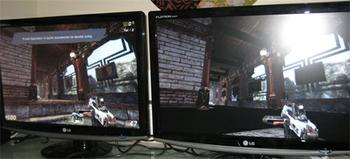From time to time, an unheard of company comes along, takes a rather obvious theory, and vows to make it happen.
Israel-based LucidLogix is one of those companies, and it has signalled its intent to allow GPUs from one vendor to work together efficiently. It's a simple idea in theory, and both AMD and NVIDIA have been allowing similar cards of their own to run in multi-GPU configurations with the use of their CrossFire and SLI technologies.
By using a compositing chip, Hydra 100, and software that sits in between a system's DirectX/OpenGL and GPU drivers, Lucid wants to make multi-GPU agnostic of profiles. All you need is a system that's capable of running multiple cards, usually for multi-monitor support, and Hydra 100 does the rest.
By having the interface between the driver and API, it'll grab hold of graphics information before it gets to the GPUs and intelligently break it up into tasks. Those rendering tasks are then distributed to multiple GPUs - intelligently, of course, with the power of the GPU dictating the tasks received. Once rendered, the data is sent back to one GPU and output to the monitor. Simple, right?
It all sounds like a mighty good idea, in theory, and Lucid has shown it off by using a demo setup which uses multiple displays to highlight different GPUs carrying out different tasks. In the below image, the monitor on the right shows that a particular GPU is working only on certain areas, and the rest of the image remains blank. Merge it all together with the data from the other GPUs, and you get the complete image as seen on the left monitor.
The huge advantage here is that it's platform independent. Your graphics drivers are pretty much irrelevant, bang any selection (same manufacturer) of up to four graphics cards into a HYRDA-powered system, and they'll work together seamlessly.
Lucid, however, won't be manufacturing the solution itself. The chip, known as the Hydra 100, will be offered to OEMs and Lucid lists the following deployment options:
- On a desktop or notebook motherboard, connected to a standard PCIe port between the CPU subsystem and the multiple graphics add-in boards or MXM modules
- On an add-in board, enabling up to four GPUs by any one vendor, creating a new price-performance-power AiB that can be plugged into a single slot on any motherboard
- In an external pod designed to provide top-performance graphics for gamers, or, when connected to a laptop or docking station allowing people to leverage advanced graphics performance when they want
It all sounds too good to be true, but if it works as Lucid says it will, this could spell the end for SLI and CrossFire as we know it.
Lucid states that consumer-level devices are expected to reach the market in the first half of 2009, and we can't wait to see what HYDRA can do in the real world.
Official website: LucidLogix.com








